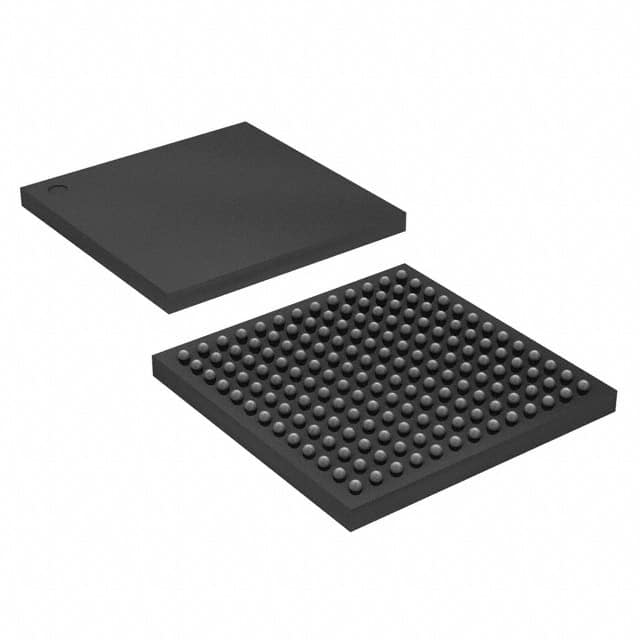MCIMX233DJM4B
Product Overview
- Category: Integrated Circuit (IC)
- Use: Microcontroller
- Characteristics:
- Low-power consumption
- High-performance ARM926EJ-S core
- Rich peripheral interfaces
- Small form factor
- Package: LQFP (Low-profile Quad Flat Package)
- Essence: A powerful microcontroller designed for various applications
- Packaging/Quantity: Available in reels of 2500 units
Specifications
- Processor: ARM926EJ-S core running at up to 454 MHz
- Memory:
- 64 KB internal SRAM
- 128 KB internal ROM
- External memory interface supporting SDRAM, NOR Flash, and NAND Flash
- Peripherals:
- USB 2.0 OTG controller
- Ethernet MAC controller
- UARTs, SPI, I2C, GPIOs
- Analog-to-Digital Converter (ADC)
- Operating Voltage: 1.71V to 3.6V
- Operating Temperature: -40°C to +85°C
Pin Configuration
The MCIMX233DJM4B microcontroller has a total of 144 pins. The pin configuration is as follows:

Functional Features
- High-performance processing capabilities
- Low-power consumption for energy-efficient designs
- Wide range of peripheral interfaces for versatile connectivity options
- Flexible external memory support for data storage
- USB OTG controller for easy device connectivity
- Ethernet MAC controller for network communication
- ADC for analog signal acquisition
- Multiple UARTs, SPI, and I2C interfaces for communication with other devices
- GPIOs for general-purpose input/output operations
Advantages and Disadvantages
Advantages: - Powerful ARM926EJ-S core for high-performance applications - Low-power consumption extends battery life in portable devices - Rich peripheral interfaces provide flexibility in design - Small form factor allows for compact designs
Disadvantages: - Limited internal memory compared to some other microcontrollers - Higher cost compared to entry-level microcontrollers
Working Principles
The MCIMX233DJM4B microcontroller operates based on the ARM926EJ-S core. It executes instructions stored in its internal or external memory, interacting with various peripherals through dedicated interfaces. The processor's clock speed determines the execution rate of instructions, enabling the microcontroller to perform tasks efficiently.
Detailed Application Field Plans
The MCIMX233DJM4B microcontroller is suitable for a wide range of applications, including but not limited to: - Industrial automation - Consumer electronics - Internet of Things (IoT) devices - Home automation systems - Medical devices - Automotive electronics
Alternative Models
If the MCIMX233DJM4B does not meet specific requirements, alternative microcontrollers with similar capabilities include: - MCIMX233CJM4B - MCIMX233DVM4B - MCIMX233DJM5C - MCIMX233CJM5C
These alternative models offer variations in features, memory capacity, or operating temperature range, providing options to suit different project needs.
Word count: 314 words
Senaraikan 10 soalan dan jawapan biasa yang berkaitan dengan aplikasi MCIMX233DJM4B dalam penyelesaian teknikal
Sure! Here are 10 common questions and answers related to the application of MCIMX233DJM4B in technical solutions:
Q: What is MCIMX233DJM4B? A: MCIMX233DJM4B is a system-on-chip (SoC) solution developed by NXP Semiconductors, specifically designed for embedded applications.
Q: What are the key features of MCIMX233DJM4B? A: Some key features of MCIMX233DJM4B include an ARM926EJ-S core running at 454 MHz, integrated peripherals like USB, UART, SPI, I2C, and GPIOs, and support for various communication protocols.
Q: What kind of technical solutions can MCIMX233DJM4B be used for? A: MCIMX233DJM4B can be used in a wide range of technical solutions, including industrial automation, consumer electronics, IoT devices, robotics, and more.
Q: How does MCIMX233DJM4B handle power management? A: MCIMX233DJM4B incorporates power management features such as dynamic voltage and frequency scaling (DVFS), low-power modes, and clock gating to optimize power consumption.
Q: Can MCIMX233DJM4B support real-time operating systems (RTOS)? A: Yes, MCIMX233DJM4B is capable of running real-time operating systems like FreeRTOS or Micrium µC/OS-II, making it suitable for time-critical applications.
Q: What programming languages can be used with MCIMX233DJM4B? A: MCIMX233DJM4B supports programming in C/C++ using development tools like GCC, Keil, or IAR Embedded Workbench.
Q: Is MCIMX233DJM4B suitable for low-power applications? A: Yes, MCIMX233DJM4B is designed to be power-efficient and can be used in battery-powered or energy-constrained devices.
Q: Can MCIMX233DJM4B handle multimedia processing? A: While MCIMX233DJM4B doesn't have dedicated hardware for multimedia processing, its ARM926EJ-S core can handle basic audio and video tasks.
Q: What kind of development boards are available for MCIMX233DJM4B? A: NXP offers the i.MX23 Evaluation Kit, which includes a development board featuring MCIMX233DJM4B along with various peripherals and connectors.
Q: Are there any community resources available for MCIMX233DJM4B? A: Yes, there are online forums, documentation, and software libraries available from NXP and the developer community to support MCIMX233DJM4B-based projects.
Please note that these answers are general and may vary depending on specific use cases and requirements.


